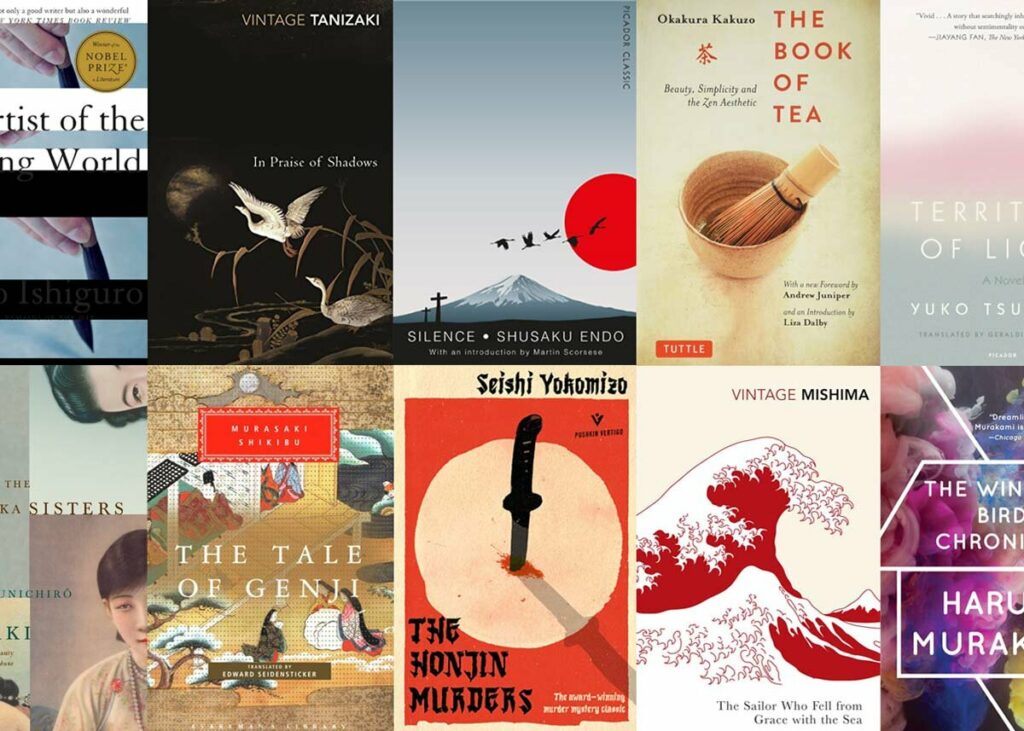Getting started with Japanese literature can be an incredibly challenging task. You browse the internet, scroll down the many pages of your local bookstores’ websites, or explore the reviews of fellow readers on social media, but it feels like being at an izayaka: there are just too many options. Which novel to pick? Will you like it? I, a self-certified bookworm, am here to help you! Let me give you a few recommendations with some of my favourite Japanese-translated novels in this Japanese Literature Guide.
The Classics for Old Souls

If you are the type of reader who likes to explore the classics before getting into the more trendy, latest releases, then maybe Sōseki Natsume’s Kokoro and Tanizaki Jun’ichiro’s Naomi are for you. These two novels and the themes brought up by their authors are easy to read and engage with. While Naomi recounts the falling in love of a thirty-something man, Jōji, with fifteen-year-old Naomi during and after the modernisation of Japan, Kokoro (trans. Edwin McClellan, 1957) follows the relationship between two men, whose lives have been tormented by their tumultuous familial and romantic relationships. Therefore this Japanese Literature Guide recommends the two. Furthermore, i am sure you have heard of Murakami, here is a list of books you can give a try which goes beyond Murakami.
For the Love of Women’s Fiction

However, maybe you are all for the more trendy novels every reader claims to devour online. If that’s the case, then you cannot miss Murata Sayaka’s Convenience Store Woman (trans. Ginny Tapley Takemori, 2018). Murata’s fresh writing style is an open window into what it means to be a woman in today’s Japan, with all the social expectations and everyday pressures. It is thus an original take on gender issues. To that, Murata also adds Japanese people’s relation and perception of sexuality, or should I say asexuality? I will let you read it!
Keeping with women’s fiction and in the same vein as Murata, Imamura Natsuko’s The Woman in the Purple Skirt (trans. Lucy North, 2022) is a quick read. Imamura modestly explores the life of the working, single Woman in the Purple Skirt, scrutinised by her narrator, the Woman in the Yellow cardigan. It is a really detailed glimpse of women in the workspace, which is a theme I really liked and found again in Yagi Emi’s Diary of A Void (trans. David Boyd, Lucy North, 2022).

Like Imamura, Yagi explores the working of the workplace and renegotiates through her protagonist the woman’s place in that space; she is highly original through the development of a female character who overtly lies about being pregnant, with the sole purpose of getting rid of her male colleagues’s forceful demands for re-instating her traditional role (as a domestic, loving carer) in the workplace. What makes Yagi such a successful author is also her sense of humour, which she does not keep for herself in this novel!
Japanese literature would not be complete without its novels about those whom nobody wants to talk about—the outcasts, the marginalised. Ōmae Ao chooses to reveal the stories of the youth in People Who Talk to Stuffed Animals Are Nice (trans. Emily Balistrieri, 2023). If the title itself sounds cute, the short stories take a darker look into young people’s struggle with social interactions and their mental health issues—depression, schizophrenia, or social anxiety. Ōmae’s stories are original and relatable in a way that both challenges Japanese people’s lives and your own.
And so is Sukegawa Durian’s Sweet Bean Paste, too (trans. Alisson Watts, 2017). This novel might be one of the latest I read, and the sincerity of Sukegawa’s writing style and emotional dimension left me in tears by the end of the novel. The story unfolds around three characters who are left on the margins of society: a leprosy victim, an old convict, and a student whose family cannot afford to send her to high school. The bond the three share is similar to that of a found family, which is a literary trope I absolutely adore! Be prepared to get hungry though, because Sukegawa gives a superb rendition of the traditional dorayaki, to the point you cannot help but salivate every time it is mentioned. Thus making it a wonderful addition to this Japanese Literature Guide.

Last but not least,
Elisa Shua Dusapin’s The Pachinko Parlour (trans. Aneesa Abbas Higgins, 2022) might be the exception to the list since the author is not Japanese but a descendant of Zainichi—Korean people who immigrated to and stayed in Japan after the Second World War. Her narrator Claire, a French-Swiss woman who is reminiscent of Shua Dusapin herself, tutors a young Japanese girl who gets curious in the pachinko parlour of Claire’s Korean grandparents. I think what is the most enjoyable about this novel is this notion of identity. That too of what makes one Japanese, and the cultural differences one might find within Japan. Furthermore you can check out our article on History of Japanese Literature to get more in depth knowledge of books.
More on my To-Be-Read Pile
The list could go on and on! On my to-be-read pile, I have a few titles that I intend to start very soon. Among them is Yū Miri’s latest family saga The End of August (trans. Morgan Giles, 2023), a 700-page novel in which the female protagonist discovers her ancestors’s history through Korean shamanism. As you may have understood, it is also part of Zainichi literature. Which I am very eager to read more about. The first few pages gave me an idea of Yū’s writing style, and Morgan Giles’s translation seems full of surprises!

I also have my eyes on The Tatami Galaxy, by Tomihiko Morimi (trans. Emily Balistrieri, 2022). Honestly speaking, the cover really caught my attention for this one. A manga-like girl observes a sort of surrealist world through her binoculars. The synopsis seems to align with this abstract cover, though: the male protagonist is offered the chance to explore parallel worlds. In which he does not have to repeat the same mistakes. Who never dreamt about starting all over again? This novel will also be for the anime lovers out there. Who may or may not have already watched the anime version of that story in this Japanese Literature Guide. But you know what they say: the books are better!
















































